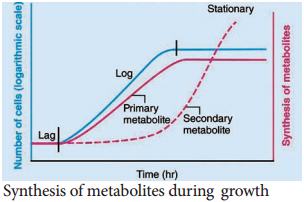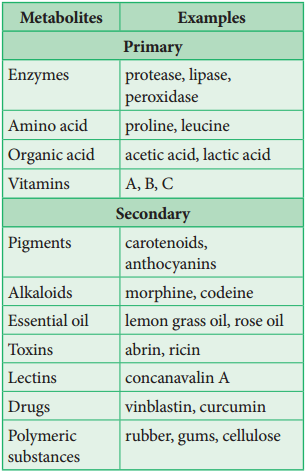Learninsta presents the core concepts of Biology with high-quality research papers and topical review articles.
Primary and Secondary Metabolites
Most plants, fungi and other microbes synthesizes a number of organic compounds called as metabolites which are intermediates and products of metabolism. The term metabolite is usually restricted to small molecules. It can be catergorized into two types namely primary and secondary metabolites based on their role in metabolic process (Figure 8.4).

Primary Metabolites
Are those that are required for the basic metabolic processes like photosynthesis, respiration, protein and lipid metabolism of living organisms.
Secondary Metabolites
Does not show any direct function in growth and development of organisms.

Organic Molecules
Organic molecules may be small and simple. These simple molecules assemble and form large and complex molecules called macromolecules. These include four main classes – carbohydrates, lipids, proteins and nucleic acids. All macromolecules except lipids are formed by the process of polymerisation, a process in which repeating subunits termed monomers are bound into chains of different lengths. These chains of monomers are called polymers.
A primary metabolite is a kind of metabolite that is directly involved in normal growth, development, and reproduction. A secondary metabolite is typically present in a taxonomically restricted set of organisms or cells (plants, fungi, bacteria, etc).
The main difference between primary metabolites and secondary metabolites is that primary metabolites are directly involved in primary growth development and reproduction whereas secondary metabolites are indirectly involved in metabolisms while playing important ecological functions in the body.
Some common examples of primary metabolites include: ethanol, lactic acid, and certain amino acids. In higher plants such compounds are often concentrated in seeds and vegetative storage organs and are needed for physiological development because of their role in basic cell metabolism.
Examples of primary metabolites include proteins, enzymes, carbohydrates, lipids, vitamins, ethanol, lactic acid, butanol, etc. Some examples of secondary metabolites include steroids, essential oils, phenolics, alkaloids, pigments, antibiotics, etc.
Examples of secondary metabolites include antibiotics, pigments and scents. Secondary metabolites are produced by many microbes, plants, fungi and animals, usually living in crowded habitats, where chemical defense represents a better option than physical escape.
Metabolites are intermediate end products of metabolism. Primary metabolites are essential for the proper growth of microorganisms. Secondary metabolites are formed near the stationary phase of growth and are not involved in growth, reproduction and development.
The antibiotics are defined as “the complex chemical substances, the secondary metabolites which are produced by microorganisms and act against other microorganisms”. Those microorganisms which have capacity to produce more antibiotics can survive for longer time than the others producing antibiotics in less amount.
Definition:
A primary pollutant is an air pollutant emitted directly from a source. A secondary pollutant is not directly emitted as such, but forms when other pollutants (primary pollutants) react in the atmosphere.
Secondary metabolites are compounds that are not required for the growth or reproduction of an organism but are produced to confer a selective advantage to the organism. For example, they may inhibit the growth of organisms with which they compete and, as such, they often inhibit biologically important processes.